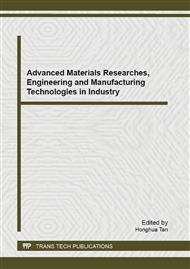[1]
G. P. Pan, S. Yang: Fireworks Learning(Beijing University of Science and Technology Press, Beijing 1997).
Google Scholar
[2]
D. H. Ouyang, H. Guan and G. P. Pan: Study on the bubble and noise of exit from pyrotechnic composition combustion underwater base on high speed photography, Acta Acustica Vol. 35 ( 2010) , pp.641-645.
Google Scholar
[3]
D. H. Ouyang, H. Guan and G. P. Pan: Effect of thermite content on acoustic radiation characteristics of pyrotechnic composition underwater combustion. Chinese Journal of Energetic Materials Vol. 18 (2010), pp.55-57.
Google Scholar
[4]
John, C., Watson, U.S. Patent2, 994, 268. (1961).
Google Scholar
[5]
E. Anderson, U.S. Patent3, 099, 813. (1963).
Google Scholar
[6]
J. Hartmann, T. Birgit: A new acoustic generator. the air-jet generator. Journal of science instruct Vol. 4 (1927), pp.101-111.
Google Scholar
[7]
X. Y. Wang, M. D. Zhao, S. W. Ma, J. Li: Research of fluid field of Hartmann whistle based on Fluent. Journal of Xi`an University of Posts and Telecommunications Vol. 16 (2011), pp.44-46.
Google Scholar
[8]
G. J. Sreejith, S. Narayanan, K. Sriniavasan: Studies on tapered resonance tubes. 37th AIAA Fluid Dynamics Conference and Exhibit (2007).
DOI: 10.2514/6.2007-3873
Google Scholar
[9]
N. Feng: Ultrasound Manua( Nanjing University Press, Nanjing 1999).
Google Scholar
[10]
M. J. Stanek, G. Raman, V. Kibens, J. A. Ross, J. Odedra: Suppression of cavity resonance using high frequency forcing-the characteristic signature of effective devices. American Institute of Aeronautics and Astronautics Vol. 2128 (2001), p.204.
DOI: 10.2514/6.2001-2128
Google Scholar
[11]
B. Lu: Acoustic propagation property and application of Hartmann acoustic generator. Journal of the University of Petroleum, China Vol. 28 (2004), pp.123-125.
Google Scholar
[12]
H. Sprenger: Ueber thermische Effekte in Resoanzrohern. Fed Inst Tech Zurich Vol. 21 (1954), pp.18-35.
Google Scholar
[13]
G. Raman, A. Mills, V. Kibens, Development of powered resonance-tube actuators for aircraft flow control applications. Journal of Aircraft Vol. 41 (2004), pp.1306-1314.
DOI: 10.2514/1.144
Google Scholar
[14]
N. Li, J. F. Chen, J. G. Huang: Sounding mechanisms and characteristics of various underwater sound sources. Applied Acoustics Vol. 28 (2009), pp.241-248.
Google Scholar
[15]
M. J. Lighthill:. On sound generated aerodynamically Ⅰ. General theory, Proc. R. Soc., London. (1952).
Google Scholar
[16]
C. G. Feng, Q. X. Zeng: Chemical Oscillation and Chemical Waves(Beijing Institute of Technology Press, Beijing 2004).
Google Scholar
[17]
J. Hartmann: Construction, performance and design of the acoustic air-jet generator. Kgl. Danske Vidensk. Selsk. Math. &Medd Vol. 16 (1939), pp.140-149.
Google Scholar
[18]
A. B. Cain, E. J. Kerschen, G. Raman: Simulation of acoustic characteristics and mechanisms of powered resonance tubes. 8th AIAA /CEAS Aeroacoustics Conference and Exhibit. (2002).
DOI: 10.2514/6.2002-2400
Google Scholar
[19]
A. Hamed, K. Das, D. Basu: Numerical simulation of unsteady flow in resonance tube. 40th AIAA Aerospace Sciences Meeting and Exhibit. (2002).
DOI: 10.2514/6.2002-1118
Google Scholar
[20]
R. S. Chen, G. Q. Wang, X. J. Gao: Research on acoustic characteristics of Hartmann acoustic generator. Technical Acoustics Vol. 31 (2012), pp.335-339.
Google Scholar


